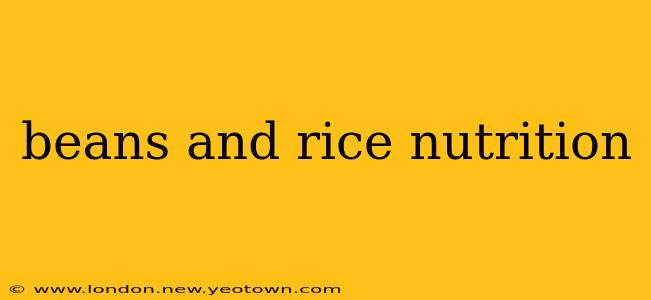The aroma alone is enough to transport you—the comforting scent of simmering beans and rice, a culinary staple across cultures for centuries. But beyond its delicious simplicity lies a nutritional powerhouse, a surprisingly complete protein source, and a budget-friendly meal that can support your overall health. Let's delve into the fascinating world of beans and rice nutrition.
What are the nutritional benefits of beans and rice?
Beans and rice together offer a remarkable synergy of nutrients. Imagine this: a humble bowl, brimming with fiber, protein, and essential vitamins and minerals. This isn't just sustenance; it's a carefully balanced meal that fuels your body and supports optimal well-being. The combination is particularly impressive because each component complements the other's nutritional gaps. Beans are rich in the amino acid lysine, which is limited in rice, while rice provides the amino acid methionine, less abundant in beans. Together, they form a near-complete protein profile, rivaling many animal-based sources.
Are beans and rice a complete protein?
This is a question that often arises, and the answer is nuanced. While neither beans nor rice alone are complete proteins (meaning they don't contain all nine essential amino acids in sufficient quantities), when combined, they create a more complete protein source. The essential amino acids present in beans compensate for the deficiencies in rice, and vice-versa. This "complementary protein" effect makes them a valuable protein source for vegetarians, vegans, and anyone seeking to diversify their protein intake.
How many calories are in beans and rice?
The calorie count of beans and rice varies significantly depending on the type of beans, the cooking method, and the portion size. A typical serving of about 1 cup of cooked beans and 1 cup of cooked rice can range from 300-500 calories. However, this is a broad estimate. For precise calorie information, refer to specific nutritional databases or use a nutrition tracking app. Remember, factors such as added fats (like oil used in cooking) or condiments will also significantly affect the total calorie count.
What are the best types of beans and rice to use?
The beauty of this dish lies in its adaptability! There’s a vast world of beans and rice varieties to explore. Black beans are known for their antioxidant properties, kidney beans are a great source of folate, and pinto beans offer a creamy texture and mild flavour. Similarly, brown rice offers more fiber than white rice, contributing to better digestion and satiety. Experimentation is encouraged! Try different bean and rice combinations to find your preferred flavor profile and nutritional balance.
Is beans and rice healthy for weight loss?
Beans and rice can indeed be part of a healthy weight loss strategy. Their high fiber content promotes satiety, meaning you'll feel full for longer, reducing overall calorie intake. The high protein content also aids in muscle building and metabolism, contributing to weight management. However, portion control is key. Overeating, even healthy foods, can lead to weight gain. Incorporating beans and rice into a balanced, calorie-controlled diet can be effective for weight loss.
What are the potential downsides of eating beans and rice?
While beans and rice are incredibly healthy, some individuals might experience gastrointestinal discomfort like gas or bloating, particularly when initially increasing their consumption. This is due to the high fiber content. Gradually increasing your intake and staying hydrated can help mitigate these effects. Also, certain types of beans, like kidney beans, contain lectins, which can cause digestive issues if not properly cooked. Always ensure your beans are thoroughly cooked before consumption.
Beans and rice—a simple dish with profound nutritional benefits. This culinary combination offers a delicious, affordable, and healthy meal option for everyone, contributing to a balanced and fulfilling diet. Remember to adjust portion sizes to meet your individual caloric needs and always explore different bean and rice varieties to find your favorite!

